
- •Contents
- •Foreword
- •How to use this book
- •Advisory boards
- •Contributing writers
- •Contributing illustrators
- •What is an insect?
- •Evolution and systematics
- •Structure and function
- •Life history and reproduction
- •Ecology
- •Distribution and biogeography
- •Behavior
- •Social insects
- •Insects and humans
- •Conservation
- •Protura
- •Species accounts
- •Collembola
- •Species accounts
- •Diplura
- •Species accounts
- •Microcoryphia
- •Species accounts
- •Thysanura
- •Species accounts
- •Ephemeroptera
- •Species accounts
- •Odonata
- •Species accounts
- •Plecoptera
- •Species accounts
- •Blattodea
- •Species accounts
- •Isoptera
- •Species accounts
- •Mantodea
- •Species accounts
- •Grylloblattodea
- •Species accounts
- •Dermaptera
- •Species accounts
- •Orthoptera
- •Species accounts
- •Mantophasmatodea
- •Phasmida
- •Species accounts
- •Embioptera
- •Species accounts
- •Zoraptera
- •Species accounts
- •Psocoptera
- •Species accounts
- •Phthiraptera
- •Species accounts
- •Hemiptera
- •Species accounts
- •Thysanoptera
- •Species accounts
- •Megaloptera
- •Species accounts
- •Raphidioptera
- •Species accounts
- •Neuroptera
- •Species accounts
- •Coleoptera
- •Species accounts
- •Strepsiptera
- •Species accounts
- •Mecoptera
- •Species accounts
- •Siphonaptera
- •Species accounts
- •Diptera
- •Species accounts
- •Trichoptera
- •Species accounts
- •Lepidoptera
- •Species accounts
- •Hymenoptera
- •Species accounts
- •For further reading
- •Organizations
- •Contributors to the first edition
- •Glossary
- •Insects family list
- •A brief geologic history of animal life
- •Index
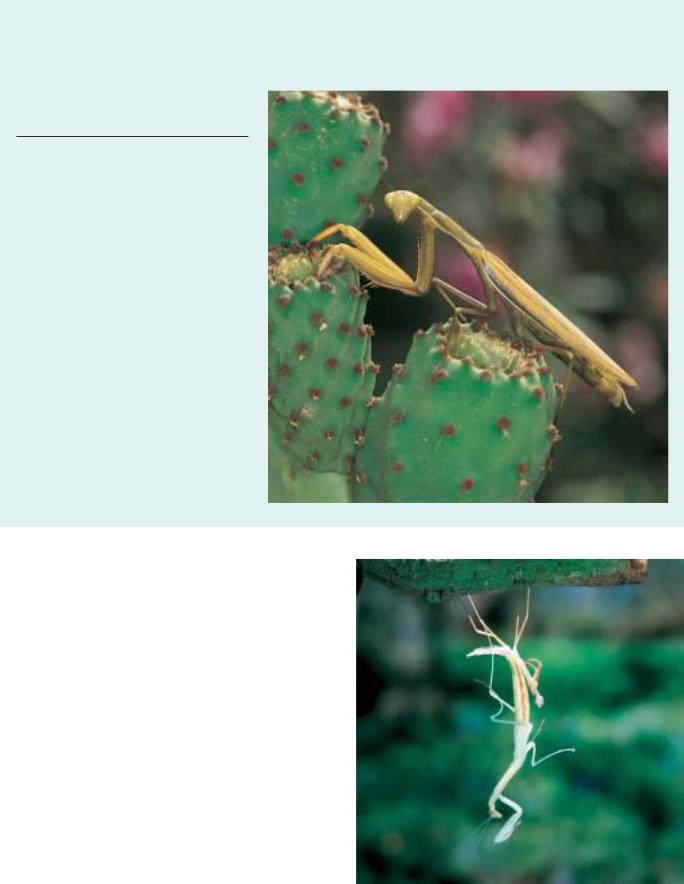
●
Mantodea
(Mantids)
Class Insecta
Order Mantodea
Number of families 15
Photo: A praying mantis (Mantis religiosa) on a prickly pear in Spain. (Photo by J-C Carton. Bruce Coleman, Inc. Reproduced by permission.)
Evolution and systematics
Praying mantids evolved during the early Cenozoic era (65 million years ago) from the cockroaches. Although it is widely accepted that mantids are related most closely to the cockroaches, the higher classification of mantids continues to be debated. Some entomologists contend that mantids should be grouped with the cockroaches in a single order, Dictyoptera, whereas others believe that the two groups should be placed in their own orders, Mantodea, the praying mantids, and Blattodea, the cockroaches. The latter approach is followed in this chapter.
The order Mantodea comprises 15 families that contain 434 genera and 2,300 species. The neotropical families Chaeteessidae and Mantoididae and the Old World family Metallyticidae all contain a single genus each and are considered by experts to be the most primitive mantid families. The Amorphoscelidae and Eremiaphilidae are two small families diversified throughout Africa and Asia. These five families generally have a thorax (pronotum) that is more or less square, as contrasted with the remaining families, whose pronotums are relatively elongated. The vast majority of mantids are grouped into these remaining families: Mantidae, Hymenopodidae, Acanthopidae, Liturgusidae, Tarachodidae, Thespidae, Iridopterygidae, Toxoderidae, Sibyllidae, and Empusidae. Many
A Japanese praying mantis (Paratenodera aridifolia) larva changing skin. (Photo by Kim Taylor. Bruce Coleman, Inc. Reproduced by permission.)
Grzimek’s Animal Life Encyclopedia |
177 |
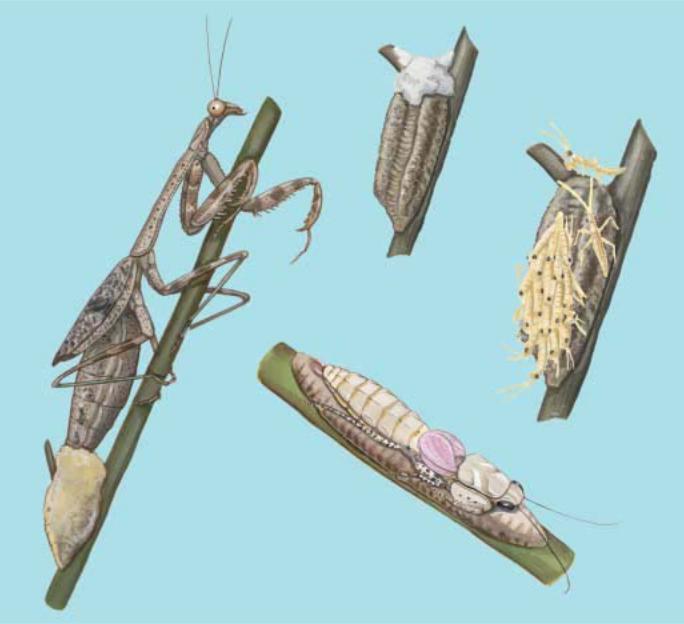
Order: Mantodea |
Vol. 3: Insects |
b
1a
c
2
A Carolina mantis (Stagmomantis carolina) makes an oothecea (1a), which overwinters on its own (1b), and the young emerge in spring (1c). In contrast, Tarachodula pantherina (2) stands guard over her eggcase until the young emerge. (Illustration by Gillian Harris)
of the latter families were once subfamilies grouped under the Mantidae, but they have been elevated to family status.
Physical characteristics
Mantids generally are large, ranging in size from just under 0.4 in (1 cm) to more than 6.7 in (17 cm). Females usually are larger than males, sometimes twice their size. Their coloration depends primarily on where they live. Mantids that are found in savannas and meadows are straw-colored or light green. Those that inhabit leaf litter tend to be dark brown. Mantids that frequent flowers in search of prey typically are yellow, white, pink or light green.
All mantids are perhaps best known for their raptorial forelegs, which they use to capture live prey. Two rows of spines on the femur and an opposing row on the tibia (except in the family Amorphoscelidae, which has only a single femoral spine) enable them to impale prey. The number and arrangement of foreleg spines are important characteristics used by entomologists to classify mantids.
Flexible neck muscles allow mantids to turn their heads a full 180 degrees. The head is triangular in shape, except in some species, such as Gongylus gongylodes, that have an elongated vertex between the eyes. All mantids have two large, compound eyes and three small, simple eyes (ocelli). The antennae of most mantids are narrow and long and have
178 |
Grzimek’s Animal Life Encyclopedia |
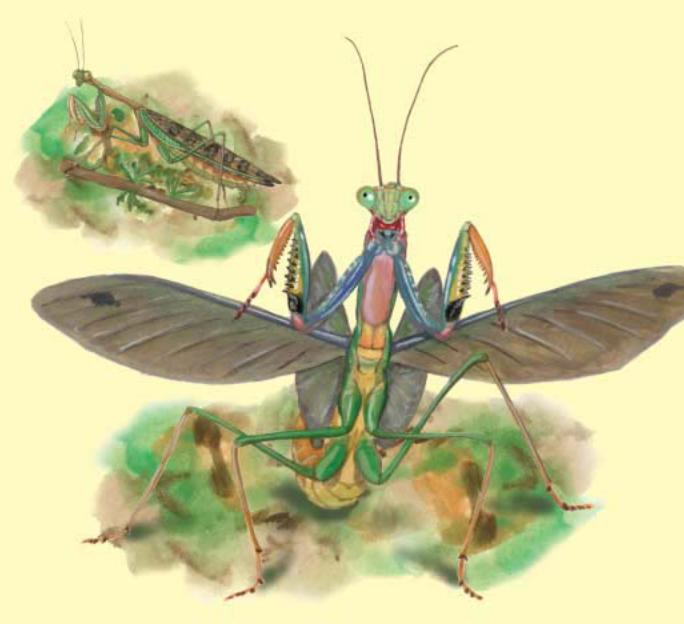
Vol. 3: Insects |
Order: Mantodea |
1
2
1. Polyspilota aeruginosa as she usually appears, cryptically colored dorsally to blend in with the foliage. 2. When attacked, her deimatic display reveals the colorful ventral surfaces and black spots on her legs. (Illustration by Gillian Harris)
many segments, but some species have antennae that are feathery, as in male G. gongylodes.
The thorax (pronotum) is longer than it is wide in most species and sometimes is expanded laterally, as in the subfamilies Deroplatyinae and Choeradodinae. Mantids generally have two pairs of wings, the forewings (tegmina) and the hind wings, but wing structure varies widely among mantid families from those having no wings (apterous) to those having two pairs of wings that are fully developed. The abdomen has 10 segments and terminates with the genitalia and a pair of multisegmented cerci.
Distribution
The majority of species are tropical and are concentrated in the rainforests of South America, Africa, and Southeast Asia. Mantid diversity decreases in temperate regions, and they are not found in boreal and tundra climates. Although most of these insects are limited in their distributions, a few species are widespread and found on more than one continent, such as the Chinese mantid, Tenodera aridifolia sinensis, and the European mantid, Mantis religiosa. These two species have become widespread since humans began transporting nursery stock with attached egg cases (ootheca) around the world.
Grzimek’s Animal Life Encyclopedia |
179 |
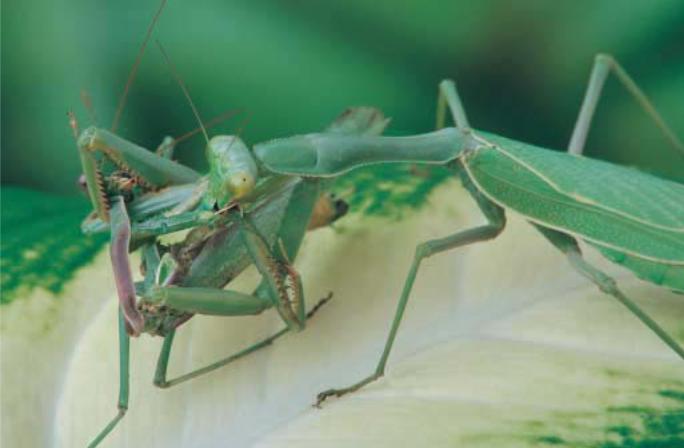
Order: Mantodea |
Vol. 3: Insects |
A female mantid (Stagmomantis limbata) eating a male. (Photo by Bob Jensen. Bruce Coleman, Inc. Reproduced by permission.)
Habitat
Mantids are entirely terrestrial and inhabit rainforests, dry forests, primary and secondary forests, grasslands, and deserts. In temperate regions, mantids complete one entire life cycle per season, whereas in the tropics, mantids can have overlapping generations.
Behavior
Numerous interesting types of behavior have been studied among the praying mantids. They are known to groom themselves frequently. Using their forelegs, they wipe their eyes and heads and then systematically clean their forelegs with their mouths. They do the same with their antennae and middle and hind legs.
Mantids have evolved certain means of defending themselves against potential predators. When faced with danger, most species attempt to run or fly away. If this does not deter the predator, the mantid may react with a startle display that includes thrusting out the forelegs, flashing out the wings, and opening the mouth. In many species the undersides of the forelegs and wings are brightly colored, so the sudden flash of these colors produces a startling effect. If these kinds of defensive behavior fail, mantids may resort to playing dead (thanatosis) or biting and pinching.
Feeding ecology and diet
Ecologically, mantids are considered top arthropod predators in the food chain. They are generalist feeders and can catch and consume arthropods primarily of equal or smaller size. Rarely, large mantids have been known to ensnare small mice, lizards, frogs, and birds. Hatchling mantids typically feed on aphids and other insects of similar size, whereas adults prey upon larger insects, including butterflies. Most mantids are opportunistic feeders and perch motionless, awaiting suitable prey; a few species actually chase down prey. Known for being cannibals, mantids consume each other if the opportunity arises. Large eyes and extraordinarily quick foreleg strikes enable these insects visually hunting predators to capture prey in 1/20 of a second.
Reproductive biology
Perhaps the best-known myth that pertains to mantids is that females always decapitate males during copulation. Although this does occur occasionally, it is not commonplace. It is true, however, that if the female cannibalizes the male during copulation, he continues to mate with her even without his head. Once the male has inserted the sperm packet into the female’s abdomen, she uses his sperm to fertilize her eggs. One to several egg cases containing 10–200 eggs (de-
180 |
Grzimek’s Animal Life Encyclopedia |
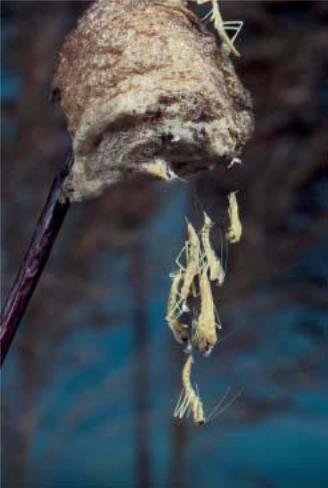
Vol. 3: Insects
pending on species) are laid over the next several weeks. Eggs are encased in a frothy liquid that hardens and protects the eggs until they hatch.
Conservation status
Although there are perhaps a few rare extant mantid species (one species is known only from a few islands in the Galapagos archipelago), there are little data regarding the overall status of mantid populations. Global warming, habitat destruction, and misuse of pesticides, however, have a detrimental effect on species. One species is listed in the IUCN Red Book: Apteromantis aptera, found in localized areas of Spain and categorized as Lower Risk/Near Threatened.
Significance to humans
Humans have both feared and revered praying mantids for more than a thousand years. Mantids have been frequent subjects of art and literature. Their prayerful pose was once thought to help travelers find a way home. The Chinese used mantids in fighting games. Indeed, there is a style of kung fu that mimics the movements of mantids.
In more practical terms, the Chinese mantid, T. a. sinensis, has been used extensively as a means of biological control for plant pests. People purchase egg cases in the winter and place them in their gardens for hatching the following spring, the goal being to have mantids consume plant pests, such as aphids. Most people do not realize, however, that mantids are generalist predators; they consume plant pests in addition to any arthropod, including other mantids and beneficial insects.
Praying mantids have become common in the pet trade. Such species as Deroplatys lobata, Hymenopus coronatus, and T. a. sinensis are especially popular among hobbyists.
Order: Mantodea
Chinese mantids (Tenodera aridifolia sinensis) hatching. (Photo by E. R. Degginger. Bruce Coleman, Inc. Reproduced by permission.)
Grzimek’s Animal Life Encyclopedia |
181 |
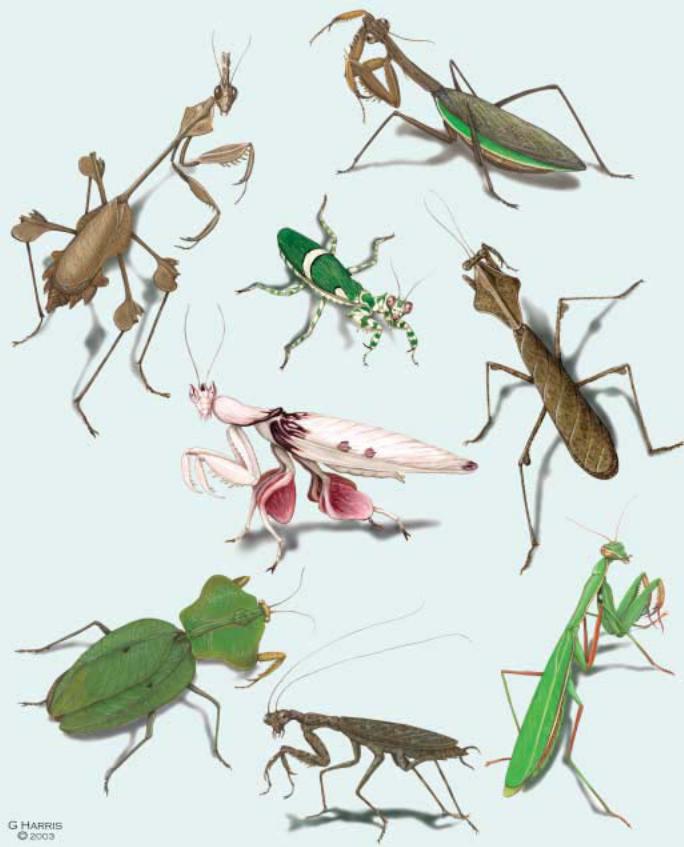
3
1
2
5
4
6
8
7
1. Wandering violin mantid (Gongylus gongylodes); 2. Boxer mantid (Theopropus elegans); 3. Chinese mantid (Tenodera aridifolia sinensis); 4. Orchid mantid (Hymenopus coronatus); 5. Dead-leaf mantid (Deroplatys lobata); 6. Choeradodis rhomboidea; 7. Liturgusa charpentieri; 8. European mantid (Mantis religiosa). (Illustration by Gillian Harris)
182 |
Grzimek’s Animal Life Encyclopedia |
